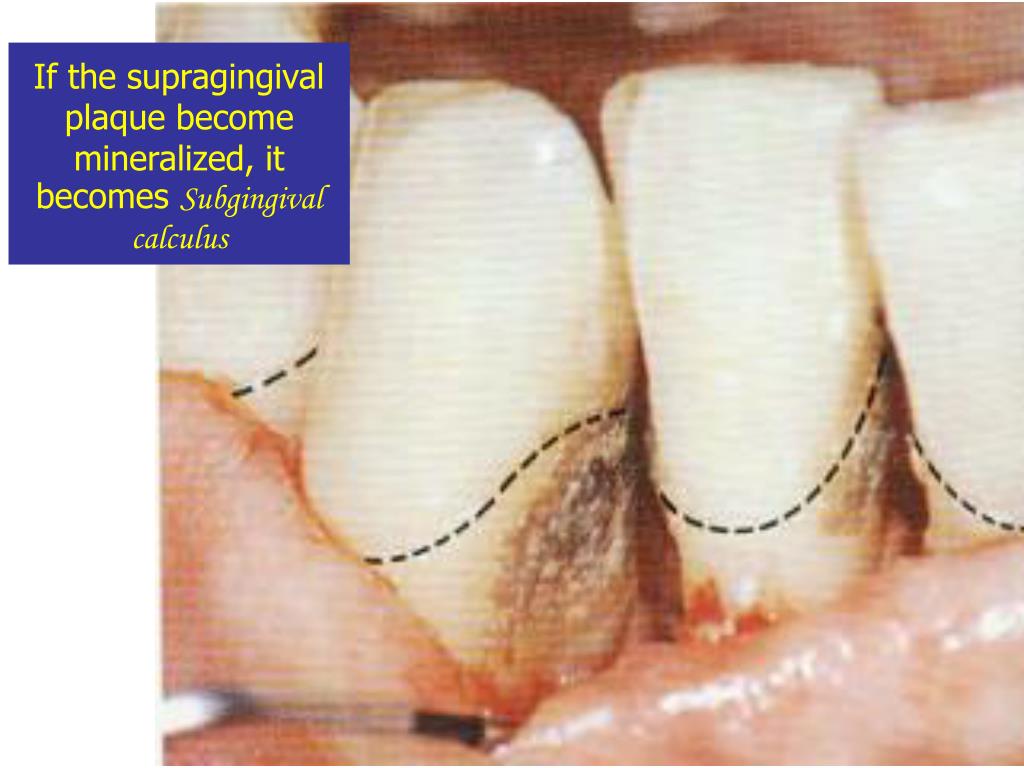

Because of its porous nature, calculus can adsorb a range of toxic products and retain substantial levels of endotoxin that can damage the periodontal tissues. The rough calculus surface may not, in itself, induce inflammation in the adjacent periodontal tissues, but may serve as an ideal substrate for subgingival microbial colonization ( Jepsen et al., 2011).Ĭause-related anti-infective therapy aims to eliminate the microbial biofilm and calcified deposits from diseased root surfaces through root surface debridement ( Jepsen et al., 2011). Their accumulation and attachment are facilitated by a roughened root surface ( Zander, 1953 Waerhaug, 1956 Mamoru et al., 2004). While subgingival calculus can cause serious dental complications, it’s one battle you can win if you keep up with good dental health habits.Bacterial plaque and calculus are accepted etiological agents in the initiation and progression of periodontal disease ( Ash et al., 1964). At these cleanings, your dentist or dental hygienist will remove any tartar to prevent inflammation and gum disease. In addition, you should visit your dentist a minimum of every six months for dental cleanings. Using an antimicrobial mouth rinse can also help to reduce the number of bacteria in your mouth. Be sure to brush your teeth twice a day and floss daily. This is why it’s important to maintain a good oral care routine at home. Since plaque is what forms tartar, preventing calculus involves cleaning plaque off your teeth regularly to prevent mineralization. Periodontal surgery may also be necessary to treat any bone loss. Treatment of periodontitis usually involves scaling and root planing to remove all of the tartar. When tartar builds up in the pocket, the bacteria can destroy the surrounding bone and tissue structures. When this happens, the AAP notes that the gum tissue eventually begins to pull away from the teeth, forming pockets that may get infected. If left untreated, gingivitis can turn into periodontitis, where the plaque continues to spread beneath the gumline.

Luckily, the condition is often reversible with a good home care routine. Typical early-stage gum disease symptoms include red, swollen gums and minor bleeding, according to the AAP. Calculus and Periodontal DiseaseĬalculus, including subgingival calculus, is associated with gingivitis, which is the first stage of gum disease, according to a review in the Journal of Health Sciences & Research (JOHSR). Your dentist or dental hygienist uses special instruments that are designed to remove the calculus.
#Subgingival calculus removal professional
It’s important to note that, while you can clean plaque off your teeth with brushing and flossing, hard tartar can only be removed by a professional cleaning. This type of calculus is usually dark brown to greenish black in colour and can be detected with a dental instrument called an explorer. But the tartar that forms below the gumline - and is therefore not immediately visible - is known as subgingival calculus. Tartar that accumulates on your teeth above the gumline and is easily seen by your dentist or dental hygienist is called supragingival calculus, according to the IJDHS article. Once calculus forms, it then attracts more plaque, which in time can become another layer of calcified material. Calcification times can vary from person to person, depending on their salivary pH and the amount of calcium and other substances in their saliva. The average length of time for mineralization, however, is 10 to 12 days. Plaque can harden into calculus in as little as four to eight hours.

This process is what creates calculus, a hard mass of bacteria stuck to your tooth surfaces. How Calculus DevelopsĪn article published in the International Journal of Dental and Health Sciences (IJDHS) explains that plaque, which is a sticky film of bacteria that constantly forms on your teeth, can mineralize due to the exchange of calcium and phosphate ions present in your saliva. If left unremoved, subgingival calculus can lead to gum disease and tooth loss. Calculus is classified as either supragingival or subgingival, depending on its location on your teeth. This formation, also known as tartar, is a calcified mass that adheres to your teeth.

When plaque builds ups on your teeth, it can turn into an even greater dental health threat: calculus.


 0 kommentar(er)
0 kommentar(er)
